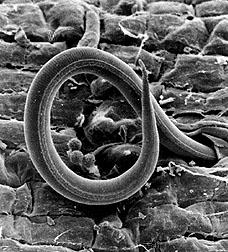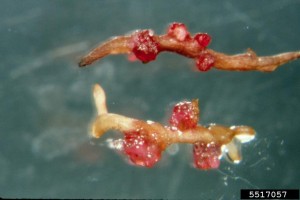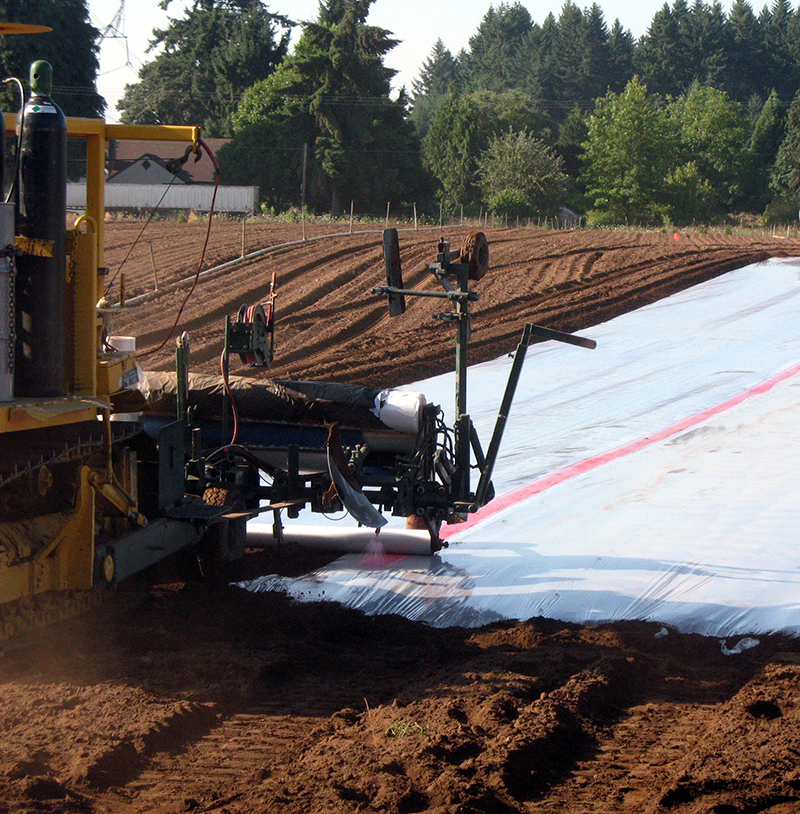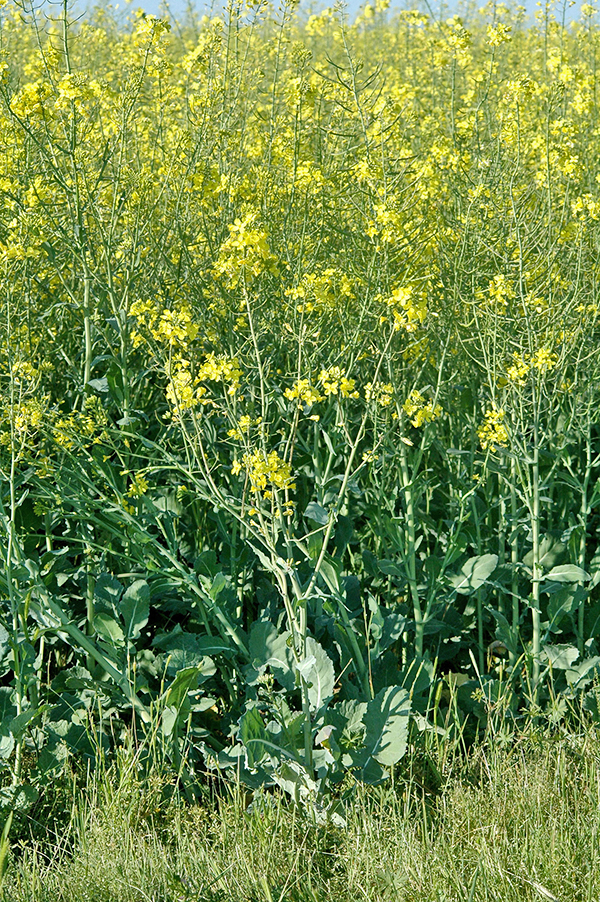Introduction

Nematodes are the most numerous multi-cellular animals on earth, with more than 80,000 species described, including about 2,500 being plant parasitic. Nematodes are elongated, non-segmented microscopic eel-like roundworms that can be beneficial or non-beneficial. They live in soil and plant root tissues. Most are considered beneficial to the soil, as they contribute to the decomposition of organic matter. Only a small percentage of nematode species are parasitic and harmful to crops, causing damage to plants by feeding on roots. Some nematodes attack soil-living insect pests and can be used as biocontrol organisms. Other insect parasitic nematodes can be applied topically to caterpillars in the same way a pesticide might be applied. But the nematodes we discuss here are classed as plant parasitic. Insect parasitic nematodes are discussed briefly on the Biological Control page of this website.
There are several nematode species that can cause problems in tree fruit orchards. Parasitic nematodes that can damage tree fruit roots are the Root Lesion, Root Knot, and Dagger nematodes in apple trees, and the Root Lesion nematode in Cherry and Pear trees. Young apple trees infected with nematodes may exhibit poor growth, and gradual decline in yields. These can be symptoms of other disorders though, making it a challenge to diagnose without sampling and looking at the roots. Nematode problems tend to be worse in poor, sandy soils where trees may be suffering water or nutrient stress. Although apple replant disease is primarily caused by fungal pathogens in the soil, nematodes can also be involved. Additional information on nematodes and replant disease can be found here, at the PNW Plant Disease Management Handbook online.

Specific Nematodes and their Damage
- Root Lesion nematodes (Pratylenchus penetrans and P. vulnes, primarily), sometimes associated with apple replant disease, penetrate roots with their piercing-sucking mouth parts (a stylet), causing damage by feeding on and migrating through the cortical tissue. Because of this they are classed as migratory endoparasites. They feed and tunnel inside the roots, and move back into the soil to find more roots to feed on. They live and reproduce in the roots, causing affected tissues to be more easily accessible to soil fungi. Severely infected roots may lack feeder roots. Apple trees, especially younger trees infected with P. pentrans have poor growth, and a gradual decline in yield. The actual feeding damage may not be obvious. A review of root lesion nematodes can be found here, (R. W. Smiley, PNW 617, March, 2010).
- Root Knot nematodes (Meloidogyne spp.), are sedentary endoparasites, meaning they tunnel into roots to find feeding sites. Once the feeding sites are established, they don’t leave the root. However, they may stick out from the roots as they grow. Their feeding leads to impaired root functions like nutrient and water uptake, as they live inside the roots. They can cause distinctive swellings called galls on the roots of affected plants. A review of root knot nematodes can be found here, (Major emerging problems with minor meloidogyne species, A. A. Elling, Phytopathology, 103(11):1092-1102, November, 2013).
- Dagger nematodes (Xiphinema americanum) are migratory ectoparasites, that attack roots from the outside, feeding on epidermal cells with their long stylets. They are commonly vectors of viruses, for example the tomato ringspot virus, which causes apple union necrosis and decline (especially for Red Delicious on M106 rootstocks), and the Cherry rasp leaf virus (CRLV). Additional information about dagger nematodes and CRLV can be found here, (First report of Xiphinema rivesi, (Nematoda, Longidoridae) in Washington State, 98(7), July, 2014).
General Symptoms
Recognizing nematode damage and symptoms can be problematic. Depending on the species and density of the nematode population, the tree’s susceptibility, and the environmental conditions, you may not detect damage symptoms. If otherwise healthy, many trees can tolerate moderate levels of parasitization without sustaining a significant loss in production. However, when nematodes are a problem you will see circular groupings of trees with poor growth in an orchard that otherwise looks healthy. These are due to pockets of higher population densities. Untreated, these patches may spread. Notable aboveground symptoms of nematode damage are lack of vigor, twig dieback, and decline in growth and yield. Infestation to older trees may include chlorosis, orange bark, higher susceptibility to fruit skin disorders and reduced fruit size. Belowground symptoms include poor growth of feeder roots and main roots and soil adhering to roots. Root knot nematode infestations cause a characteristic swelling of the roots, called galls. The only way to confirm that observed symptoms are caused by nematodes is through close examination of the soil and/or root tissues.
Sampling
To make management decisions, it is important to know the nematode species present and their population densities. If a previous orchard or crop had problems caused by the same species of nematode that are listed as pests of fruit trees, population levels may be high enough to cause damage to young trees. If nematode species have not previously been identified, soil samples should be taken and sent to a diagnostic laboratory for identification. It is best to sample in late summer or early fall when populations are likely at the highest density and more easily detected. Soil and root samples are taken at the tree dripline, at a depth of between 6 inches to 36 inches depending on the point that feeder roots are present. The general procedure is to place a handful of soil in one container and a handful of feeder roots in another. It is important to sample the fine feeder roots because nematodes prefer to feed on them rather than the larger roots. Take 10 to 20 subsamples from a given area, mix soil thoroughly, and combine into one sample. When sampling single trees, take two to five subsamples, depending on the size of the tree. Damage may result at 20 to 50 nematodes per 100 g soil; however, that range of numbers is only a suggested damage level. The numbers are based on replicated studies, but local soil types, climate, moisture, and other factors vary widely, and so our numbers may not be representative. For a list of laboratories performing nematode identification and testing services visit this link. You should contact the testing laboratory prior to sampling to get handling and submission instructions, and test pricing.
Control Stategies

Nematodes are usually introduced to new areas with infested soil or plants, and can be carried from one field to another with orchard machinery. Removing old roots before replanting and choosing resistant rootstocks and certified clean plants are good preventive measures to control nematodes. Fumigants are not effective if plant residue containing nematodes (e.g. Root Knot) remains in the ground. Trees can be monitored for symptoms of decline throughout the growing season, and if nematode infestation is suspected, it is important to know the species present, and their population densities, for management decisions. Soil and root samples can be collected in areas of concern after harvest (i.e., in the fall when populations are the highest) to determine types and numbers of nematodes. (See the above section on sampling and testing.)
Growers use pre-plant fumigants, post-plant nematicide applications, short-term biological controls (e.g. marigolds), green manure cover crops, or biofumigants. Bio-nematicides, like Brassica and mustards can be used by organic and conventional growers. Bio-nematicides have the ability to decrease plant parasitic nematodes without affecting beneficial microorganisms and nematodes, by releasing chemical compounds that may be toxic to nematodes and other pathogens (reference). Additional information about soil fumigation can be found here.
Fumigation
Orchards have typically been pre-plant fumigated with methyl bromide or other treatments to kill soil organisms before replanting. Fumigants are broad-spectrum biocides that can have negative impacts on soil health by killing beneficial organisms. Fumigants only last for so long, then the nematode populations may return. (reference) Methyl Bromide is now being phased out under an international ban, so alternative fumigants and treatments are needed. (reference) Research at the USDA Agricultural Research Station in collaboration with Washington State University has focused on alternatives to methyl bromide fumigation. Some of these alternative methods are outlined below.
Cultural and alternative control methods

There are a variety of methods that have been employed to control nematodes:
- Fallowing is a practice where a field is planted with non-susceptible or resistant plants for a period of 3 to 5 years. For this to work, old roots should be removed prior to planting.
- Soil supplements such as mustard green manures can be used to help suppress nematodes and soil borne diseases, and to build soil quality. (For more in-depth information visit here and here.)
- Resistant nematode-free certified rootstocks or seedlings should be used. (Clean Plant Network)
- Cover cropping If the root lesion nematode P. vulnes is present, maintain a poor host cover crop for that species, such as tall fescu, red fescue, or a perennial ryegrass as an orchard ground cover. However, these are hosts for P. penetrans and should not be used if this species is present. Mustards are hosts of root knot nematodes and should be avoided if that nematode is suspected to be present. Certain cover crops (e.g. wheat and Sudan grass) that induce microbial shifts in the soil or act as antibiotics to suppress pathogens, have also been effective treatments for nematodes and soil borne diseases while helping soil quality (reference). And certain mulches have been found to reduce lesion nematode populations.
- Soil solarization is a method used as an alternative to fumigation. Moisten soil and cover with clear plastic. Leave in place for 4-6 weeks during the hottest part of summer. Root knot nematodes including eggs will die when soil temp reaches 125°F for 30 minutes. This works for about a year because only the top foot of soil is heated.
Resources
Select Chapters from the Pacific Northwest Plant Disease Handbook:
(J. W. Pscheidt and C. M. Ocamb, senior editors. 2015. Pacific Northwest Plant Disease Management Handbook [online]. Corvallis, OR: Oregon State University. (Accessed: 1/19/17).
- Nematodes. R. Ingham and H. J. Jensen, Oregon State University, PNW Plant Disease Management Handbook, webpage.
- Apple – Dagger Nematode, PNW Plant Disease Management Handbook, webpage.
- Apple – Root-lesion Nematode, PNW Plant Disease Management Handbook, webpage.
- Cherry – Dagger Nematode, PNW Plant Disease Management Handbook, webpage.
- Cherry – Ring Nematode, PNW Plant Disease Management Handbook, webpage.
- Cherry – Root-lesion Nematode, PNW Plant Disease Management Handbook, webpage.
- Cherry – Rasp Leaf, PNW Plant Disease Management Handbook, webpage.
- Fumigating Soils for Nematode Control, PNW Plant Disease Management Handbook, webpage.
- Orchard Soil Fumigation. T. J. Smith, WSU Extension, Chelan, Douglas and Okanogan Counties, PNW Plant Disease Management Handbook, webpage.
Alternative Control
- Brassica Seed Meal Soil Amendments Transform the Rhizosphere Microbiome and Improve Apple Production Through Resistance to Pathogen Reinfestation. M. Mazzola, S. Hewavitharana and S. Strauss. (USDA ARS, Wenatchee, WA) J. Ecology and Epidemiology. V105(4), April 2015.
- Advances in Brassicaceae Seed Meal Formulation and Application Protocol for control of apple replant disease, M. Mazola, USDA ARS, poster, December 2010 WA St. Hort. Assoc. Mtg.
- Fumigation Alternatives, WSU-CSANR website.
General Nematode Topics
- Major emerging problems with minor Meloidogyne species (Root knot nematodes), A. Elling (WSU Dept. Plant Pathology), Phytopathology, V103, 2013.
- Introduction to the Integrative Management of Plant-parasitic Nematodes, A. Peetz (USDA ARS, Corvalis, WA), Presentation, 2014.
- Pathogen & Nematode Management, WSU-CSANR website.
